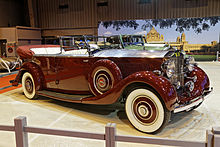Rolls-Royce Phantom III
| Rolls-Royce Phantom III | |
|---|---|
 | |
| Overview | |
| Manufacturer | Rolls-Royce Ltd |
| Production | 1936–1939 727 produced |
| Body and chassis | |
| Class | Luxury car |
| Powertrain | |
| Engine | 7338 cc (447 cubic inches) V12 |
| Transmission | 4-speed manual |
| Dimensions | |
| Wheelbase | 142 in (3607 mm) |
| Curb weight | 1,837 kg (4,050 lb)[1] (chassis only) 3,500 kg (7,700 lb)[1] (approx - with Barker & Co 4 door body) |
| Chronology | |
| Predecessor | Phantom II |
| Successor | Silver Wraith Phantom IV |

The Rolls-Royce Phantom III was the final large pre-war Rolls-Royce. Introduced in 1936, it replaced the Phantom II and it was the only V12 Rolls-Royce until the 1998 introduction of the Silver Seraph. It is the first of the three V12-powered Rolls-Royce Phantoms, with the 2003-2017 Rolls-Royce Phantom VII and 2018- Rolls-Royce Phantom VIII being the other two. 727 V12 Phantom III chassis were constructed from 1936 to 1939, and approximately 650 have survived. Although chassis production ceased in 1939 (with one final chassis being built in 1940), cars were still being bodied and delivered in 1940 and 1941. The last car, though the rolling chassis was completed in 1941, was not delivered with a body to its owner until 1947. The Phantom III was the last car that Henry Royce worked on – he died, aged 70, a year into the Phantom III's development.[2]
Engineering
The III is powered by an aluminium-alloy V12 engine of 447in³ (7.32L), having a bore of 3.25 inches (82.5 mm) and a stroke of 4.5 inches (114.3 mm). It is a pushrod engine with overhead valves operated by a single camshaft in the valley between the cylinder banks. Early cars had hydraulic tappets or, rather, a unique system of eccentric bushings in each individual rocker that was actuated by a small hydraulic piston; the eccentric bushing ensuring zero valve-lash at the rocker/valve interface. This system was changed to solid adjustable tappets in 1938. The Phantom III is unusual for its twin ignition systems, with two distributors, two coils and 24 spark plugs. Petrol is provided by a twin SU electric pump. Wire wheels are fitted as standard, but many cars carry Ace wheel discs which were fitted to improve cosmetics and to reduce the time taken to clean the wire wheels after use.
The car features on-board jacking and a one-shot chassis lubrication system, operated by a lever inside the driver's compartment. Independent front suspension by a coil spring-based system is complemented by a carryover semi-elliptical spring unit in the rear. The car has a 4-speed manual transmission with synchromesh on gears 2, 3 and 4. An overdrive gearbox was added in 1938, the ratio change being contained in the gearbox rather than in a separate unit. The car has 4-wheel servo-assisted brakes applied by cable (using a servo made under licence from Hispano-Suiza). The radiator shell is of Staybrite steel.
The sheer bulk of the car is reflected in its performance figures. An example tested in 1938 by The English Autocar magazine returned a top speed of 87½ mph (140 km/h) and a 0 - 60 mph (0 – 96 km/h) time of 16.8 seconds.[1] The overall fuel consumption quoted from that road test was 28 litres per 100 kilometres (10 mpg‑imp; 8.4 mpg‑US).[1]
Bodywork

by Barker & Co
Only the chassis and mechanical parts were made by Rolls-Royce. Car bodies were constructed and fitted by coachbuilders selected by owners or dealers, who might have cars built for showroom stock. Some of the most famous coachbuilders who produced bodies for Rolls-Royce cars are Barker, Park Ward, Mulliner, Hooper and Thrupp & Maberly. Body types as well as limousines included saloons, coupés, and convertibles. A handful of used cars have been converted to hearses and shooting brakes.
Film and television appearances
In 1964, 25 years after the end of production, the villainous Auric Goldfinger (played by Gert Fröbe) was driven by chauffeur Oddjob in a black and yellow Phantom III in the James Bond film Goldfinger, knowing that its great strength would be able to hold the weight of the vast amounts of gold that he smuggled around Europe.[3][better source needed]
References
- ^ a b c d "Hochadel: Rolls-Royce 12-zylinder aus englischem Adelsbesitz, der nach Deutschalnd verkauft wurde". Auto Motor u. Sport. Heft. 25 1977: Seite 72–82. 7 December 1977.
- ^ Cheetham, Craig (2004). Vintage Cars - The Finest Prewar Automobiles. Rochester, United Kingdom: Grange Books. p. 31. ISBN 1840136359.
- ^ "james bond multimedia | 1937 Rolls-Royce III images". www.jamesbondmm.co.uk. Archived from the original on 17 April 2009.